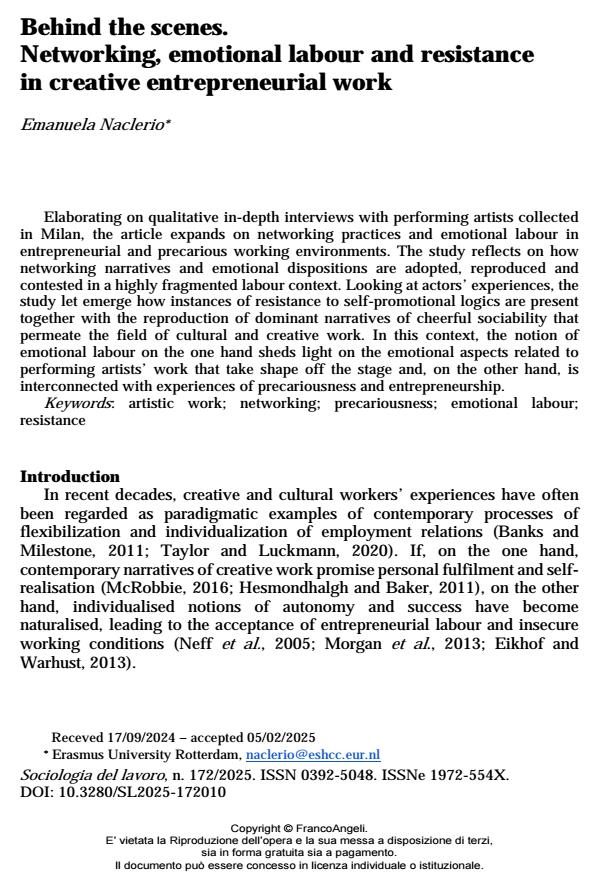Behind the scenes. Networking, emotional labour and resistance in creative entrepreneurial work
Titolo Rivista SOCIOLOGIA DEL LAVORO
Autori/Curatori Emanuela Naclerio
Anno di pubblicazione 2025 Fascicolo 2025/172
Lingua Inglese Numero pagine 20 P. 205-224 Dimensione file 180 KB
DOI 10.3280/SL2025-172010
Il DOI è il codice a barre della proprietà intellettuale: per saperne di più
clicca qui
Qui sotto puoi vedere in anteprima la prima pagina di questo articolo.
Se questo articolo ti interessa, lo puoi acquistare (e scaricare in formato pdf) seguendo le facili indicazioni per acquistare il download credit. Acquista Download Credits per scaricare questo Articolo in formato PDF

FrancoAngeli è membro della Publishers International Linking Association, Inc (PILA)associazione indipendente e non profit per facilitare (attraverso i servizi tecnologici implementati da CrossRef.org) l’accesso degli studiosi ai contenuti digitali nelle pubblicazioni professionali e scientifiche
Elaborating on qualitative in-depth interviews with performing artists collected in Milan, the article expands on networking practices and emotional labour in entrepreneurial and precarious working environments. The study reflects on how networking narratives and emotional dispositions are adopted, reproduced and contested in a highly fragmented labour context. Looking at actors’ experiences, the study let emerge how instances of resistance to self-promotional logics are present together with the reproduction of dominant narratives of cheerful sociability that permeate the field of cultural and creative work. In this context, the notion of emotional labour on the one hand sheds light on the emotional aspects related to performing artists’ work that take shape off the stage and, on the other hand, is interconnected with experiences of precariousness and entrepreneurship.
Attraverso una analisi qualitativa di interviste in profondità raccolte con artisti performativi nel contesto milanese, l’articolo approfondisce le pratiche di networking e il lavoro emozionale in ambienti di lavoro caratterizzati da imprenditorialità e precarietà. Lo studio riflette su come gli attori entrano in relazione con la necessità di sviluppare reti professionali e su come una serie di caratteristiche emotive vengano adottate, riprodotte e contestate in un contesto lavorativo altamente frammentato. Attraverso l’analisi delle esperienze degli artisti performativi, emerge come istanze di resistenza alle logiche di auto-promozione coesistono con la riproduzione di narrazioni entusiaste caratteristiche del lavoro culturale e creativo. In questo contesto, la nozione di lavoro emozionale da un lato permette di osservare gli aspetti emotivi legati al lavoro degli artisti che prendono forma dietro le quinte, mettendo in luce come siano strettamente legati ad esperienze di precarietà e imprenditorialità nel contesto professionale.
Parole chiave:lavoro artistico, networking, precarietà, lavoro emozionale, agency.
Emanuela Naclerio, Behind the scenes. Networking, emotional labour and resistance in creative entrepreneurial work in "SOCIOLOGIA DEL LAVORO " 172/2025, pp 205-224, DOI: 10.3280/SL2025-172010